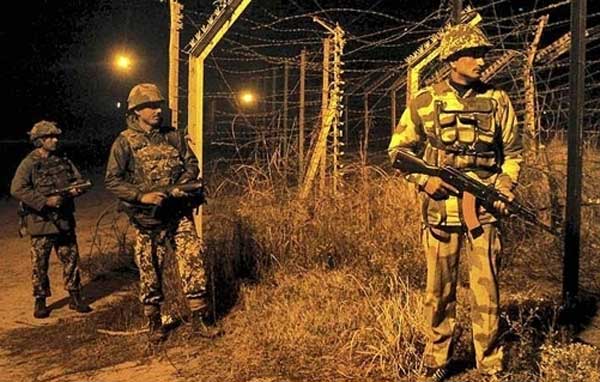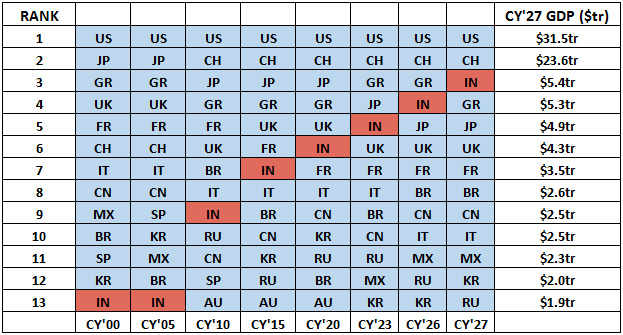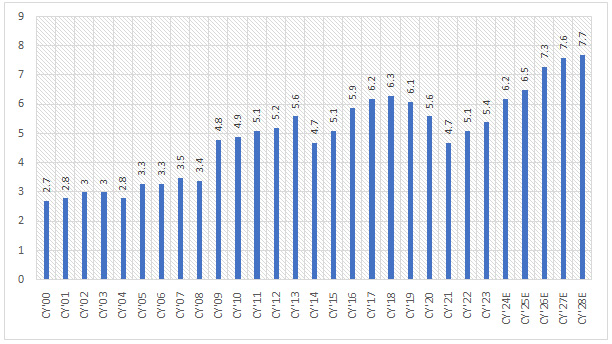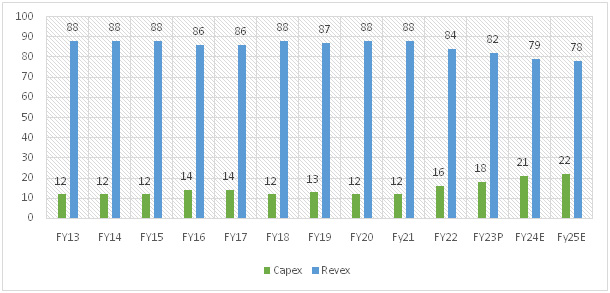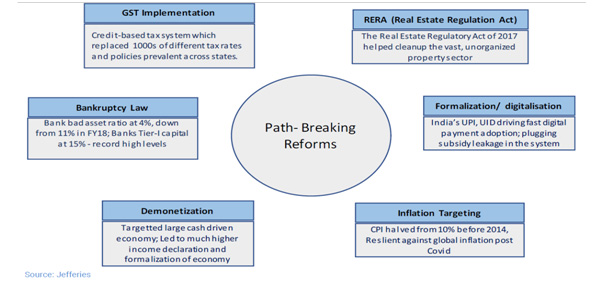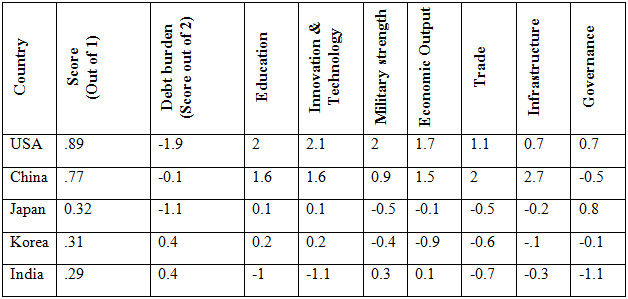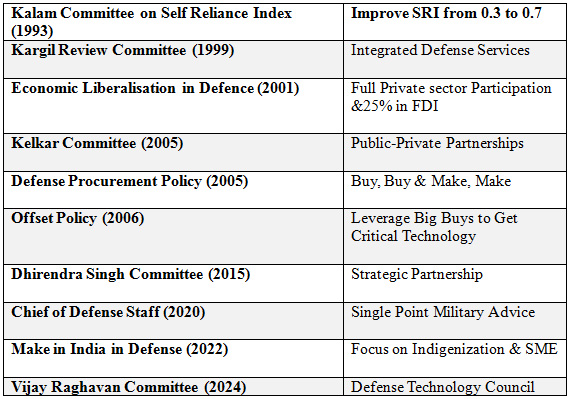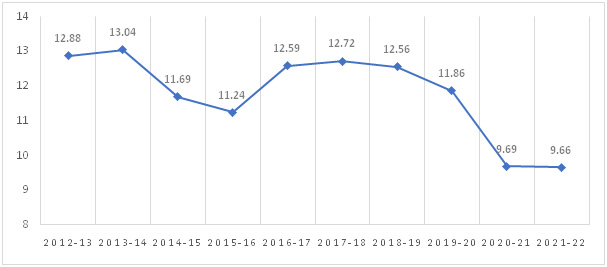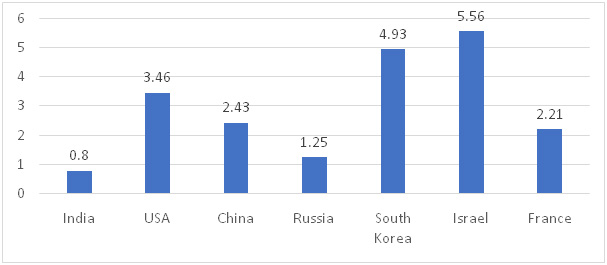IDR Blog
National Security and Role of Self-Reliance in Military Capability
Introduction
Epictetus, the philosopher wrote, we can not choose our external circumstances but we can always choose how we respond to them. It is the role of leaders to ensure our security from external circumstances and inspire people and institutions to preserveour sovereignty. There is a critical linkage of national security with economic power. The economic power of a country is in turn linked substantially with military industry capability. Further, the degree of self-reliance that we have in terms of critical technologies becomesan important parameter for a country in the event of external aggression. China has shown how economic dominance and its position as a prime manufacturing powerhouse globally has helped it to compete with a behemoth like the USA. This paper tries to analyze in the context of India, how its economic ascendency after economic liberalization has helped it to become a global economic power (b) the fault lines in our human development, (c) policy evolution in the defense manufacturing sector after 2000 and (d) the way forward.
2. India as a Global Economic Power:
The following table will bring out India’s Gross Domestic Product ( GDP) ranking in nominal US terms since 2000 and India’s Contribution to the World’s GDP growth in real terms from 2000 onwards.
Table 1: GDP ranking in nominal US $ terms
Source: IMF, Jefferies
It would be seen from the above that from the thirteenth rank in 2000 in the global GDP ranking we have moved up to fifth place by 2023 and hope to ascend to the third rank by 2027, given our sustained growth forecast at 7% per year in the next five years.
India’s contribution to the world’s GDP growth (real) is tabulated below
Source: IMF, Jefferies
From 2.7% share in real terms in 2000, we have moved to 5.4% by 2023. One of the significant reasons contributing to India’s sharp economic spurt has been contributed by the significant boost to capital expenditure as the following figure will show
Figure 2: Capex’s share in total expenditure
Source: Union Budget documents and Emkay research estimates.
As can be seen , the rise in capital expenditure as % to Central government expenditure (CGE) has moved up from 12% in 2013 to about 21% now, Thein flow of Foreign Direct Investment ( FDI) which was around 2.2 billion dollars in 2002, has now gone up to around 80 billion dollars and was least affected even during the pandemic years.
Path-breaking reforms in India over the last decade:
The following flow chart documents the 6 major reformsthat have contributed to higher growth and better financial health of the banking sector:
Figure 3: Reforms that led to Higher growth rate in India
In particular, the Goods & Services Tax (GST) (one nation one tax) with a robust IT network has increased indirect tax collection from less than 1 lakh crore to 1.5 lakh crore. The Insolvency and Bankruptcy Code (IBC) has also gone a long way in bringing down the percentage of bad debts from 13% in 2018 to around 3.4% lately. The other most significant move has been India’s UPI and digital payment system which has plucked the subsidy leakage substantially. The (Jan Dhan, Mobile, and Aadhar) JAM trinity has triggered a significant improvement in digitization in the financial sector.
3. The Fault Lines
3.1 Country Power Index
The above trends, however, do not bring out some of the major concerns that India confronts. Ray Dalio, who has developed a country power index 2023, has brought out why India has scored 0.29 (7th position) out of a score of 1, despite its achievement of 7% growth, over the last decade.
Table 2: Comparative analysis of the status of India in-country power index
Source: Country power index. 2023
It would be seen from the above that the main areas where India needs to catch up are education, innovation technology, and trade whereas China which has a score of 0.77 outscores India, very significantly. Our low HDI (Human Development Index) is largely responsible for our poor rating
3.2 Human development trends
The UNDP brings out the human development indices for different countries which captures not only the per capita Gross National Income (GNI) but also the priority the country accords to quality schooling and healthcare. The following table shows India’s achievement in terms of building human development capability in terms of health and education
Table 4: Global Trend: Human Development Index
| Country | HDI | Life Expectancy | Mean Years of Schooling | GNI ($ at PPP) |
| Sweden | 0.947 | 83 | 12.6 | 54489 |
| Germany | 0.942 | 80.6 | 14.1 | 54534 |
| USA | 0.921 | 77.2 | 13.7 | 64765 |
| Japan | 0.925 | 84.8 | 13.4 | 42274 |
| Korea | 0.925 | 83.7 | 12.5 | 44501 |
| Russia | 0.822 | 69.4 | 12.8 | 27166 |
| China | 0.768 | 78.2 | 7.6 | 17504 |
| Brazil | 0.754 | 72.8 | 8.1 | 14370 |
| India | 0.633 | 67.2 | 6.7 | 6590 |
Source: HDR; 2022
The national account data shows that in 2021-22, education and health had a modest size in our economy accounting for 4% and 1.6% respectively of the gross value added. As Prof. Amartya Sen rightly brings out this has to increase significantly to 3% and 6% respectively if we aim to become a developed country. Prof. Nitin Desai formerly chief economic advisor, GOI, in a recent article, has brought out, “Education and Health matter not just for growth but are also an essential part of goals of development which should include the quality of life.”
4. Major policy initiatives for bolstering military industry capabilities
The military manufacturing sector has been the exclusive preserve of the government through the defense PSUs and ordnance factors as per the Industrial Policy resolution of 1956. The 10 major policy initiatives are tabulated below.
Table 5: Major policy initiative for bolstering MIC:
The Kalam committee had assessed India’s Self-reliance Index (SRI) as 30%, which needs to be boosted to 70% in a decade by bolstering indigenous design capability, faster technology absorption, and partnership with design houses and (Original Equipment Manufacturers) OEMs After the disastrous experience in Kargil the government had paid better attention to integration of MoD with the Service Headquarters and coordinated intelligence gathering. A decade later after economic liberalization, the defense sector witnessed full participation of the private sector in defense manufacturing and 25% FDI inflow. This was the first attempt to bust the monopoly presence of the public sector Undertakings (PSUs) and Ordinance factories. The Kelkar committee in 2005 went a step forward by promoting public-private partnerships, the defense procurement policy made India’s procurement system transparent to all suppliers and gave primacy to Make in India which puts a premium on developing indigenous technology that can be converted into production later on. The offset policy in 2006, drawing on the experience of Brazil in developing Embraer aircraft by availing technology from the USA tried to leverage India’s big-ticket acquisition to get critical technology, FDI, and outsourcing orders.
The Dhirendra Singh committee in 2015 made a strong pitch for a strategic partnership between the defense PSUs and the private sector in India. The Chief of Defence Staff which was one of the major recommendations of the Kargil review committee and was put on the back burner for a long time saw the light of the day in 2020 with the appointment of CDS. It has helped the defense services acquirea preeminent position as single-point military advice, thereby deluding civilian control over military advice. Make in India in defense focuses on greater indigenization, protecting domestic manufacturers from imports and bolstering the footprints of SMEs. The latest committee of Vijay Raghavan suggests the creation of a defense technology council helmed by the prime minister with NSA and CDS and the private sector, playing a critical role in improving our record instate-of-the-art technology. The DTC is being registered by the DRDO.
Defence Budget
The following graph will show how defence budget as a % of CGE has moved during the last decade:
Figure 6: Defence budget as % to CGE
Source: Defence Services Estimates
It would be seen from the above that it has plummeted from 13% in 2013-14 to around 9.66% recently. Besides, the defense budget as a % of GDP is also witnessing a reduction from about 3% to about 2.4%.
India as the largest Importer of conventional arms
The following table will provide the trends of major exporters and importers globally:
Table 6: Largest exporter and recipient of major arms
| Exporters | Importers | ||
| Country | Share | Country | Share |
| USA | 42 | India | 9.8 |
| France | 11 | Saudi Arabia | 8.4 |
| Russia | 11 | Qatar | 7.6 |
| China | 5.8 | Ukraine | 4.9 |
| UK | 3.7 | Pakistan | 4.3 |
| Israel | 2.4 | Japan | 4.1 |
| South Korea | 2 | Egypt | 4 |
Source: SIPRI, 2023
It would be seen from the above that India is the largest importer and the USA the largest seller. Even China has a share of 6% in global arms exports
The reasons for such humungous imports is largely due to our excessive dependence on critical subsystems. The Kalam Committee had identified gaps inthe following areas.
| Sl. No | System | Gaps |
| 1 | Gas Turbine Engine | Single crystal and special coating in turbine blades FADEC |
| 2 | Missile | Uncooled FPA seekers |
| 3 | Aeronautics | Smart Aerostructures |
| Stealth Technology | ||
| 4 | Material | Nano Materials. Carbon Fibres |
| 5 | Naval System | Super Cavitating Technology |
| 6 | Sensors | AESA. Radar, RLG, INGPS |
| 7 | Communication | Software Defined Radio |
| 8 | Avionics | Gen III, II Tubes |
| 9 | Surveillance | UAVs, Satellites |
Source: Kalam Committeee
The three major areas are propulsion, weapons, and sensors. The Kaveri which was to power the LCA aircraft has failed the test and is instead powered by a GE 404 engine imported from the USA. The MBT tank is powered by a German MTU engine. The (Active Electronically Scanned Array) AESA radar is sourced from Israel and the air-to-air missile is sourced from France. DRDO’s record in terms of indigenization of these critical systems lacks credibility. There is a huge gap between promise and delivery. DRDO’s ability to develop passive seekers and Focal Plane arrays has come as croppers.
Criticality of R&D Investment
One of the prime reasons for the USA achieving its preeminent position globally is due to its huge investment in R& D. In fact as per Robert Solow, the Nobel laureate in economics, 60% of America’s growth has been contributed by research and innovation and high factor productivity. The following table will bring out the comparative position globally.
Figure 8: R&D as a percentage of GDP
Source: World Bank Data 2020
The poor share of R&D in India’s GDP is also reflected in its low self-reliance index. Besides, in developed countries, the private sector contributes nearly 60% of R&D expenditure, where it is predominantly driven by the government (90%). Israel, which was exporting only $1 million in 1995 to India moved up to $1 billion by 2005, thanks to their amazing attention to R&D and collaboration with the USA.
Concluding thoughts:
It would be seen from the above that while India has made tremendous strides in overall economic prosperity, it also displays significant gaps in human development capability in general and inadequate indigenous capability in designing critical defense subsystems, making it the largest importer of arms. This is further roiled by inadequate exposure to designing defense systems in our IITs, with the solitary exception of IIT Kharagpur in designing naval systems. India also spends less than 1% of its GDP, with the private sector a clear laggard, showing our poor record in innovation & technology as the Country Power Index shows. Make in India’s successcan not rest on protecting inefficient indigenous industries but on collaborating with OEMs and Global design houses. Kalam showed the way with JV with the Russians for producing Brahmos cruise missiles. He also successfully collaborated with Israel for the design and development of (Medium Range surface to air missiles) MR SAM. These are useful templates to emulate rather than reinventing the wheels. The announcement of the FM in the last budget to create a corpus of 1 lakh crores to catalyze R&D and private sector investment is most welcome. It was Clemenceau who wrote: War is too important to be left to the generals. A coordinated view by a Defence Technology Council helmed by the PM, with NSA, MEA, and CDS in tow and the private sector as equal partners would not only ink a map of long-term security but also build a high level of indigenization in the state of art subsystems based on partnerships.




